Catherine Hawkes
Quilts
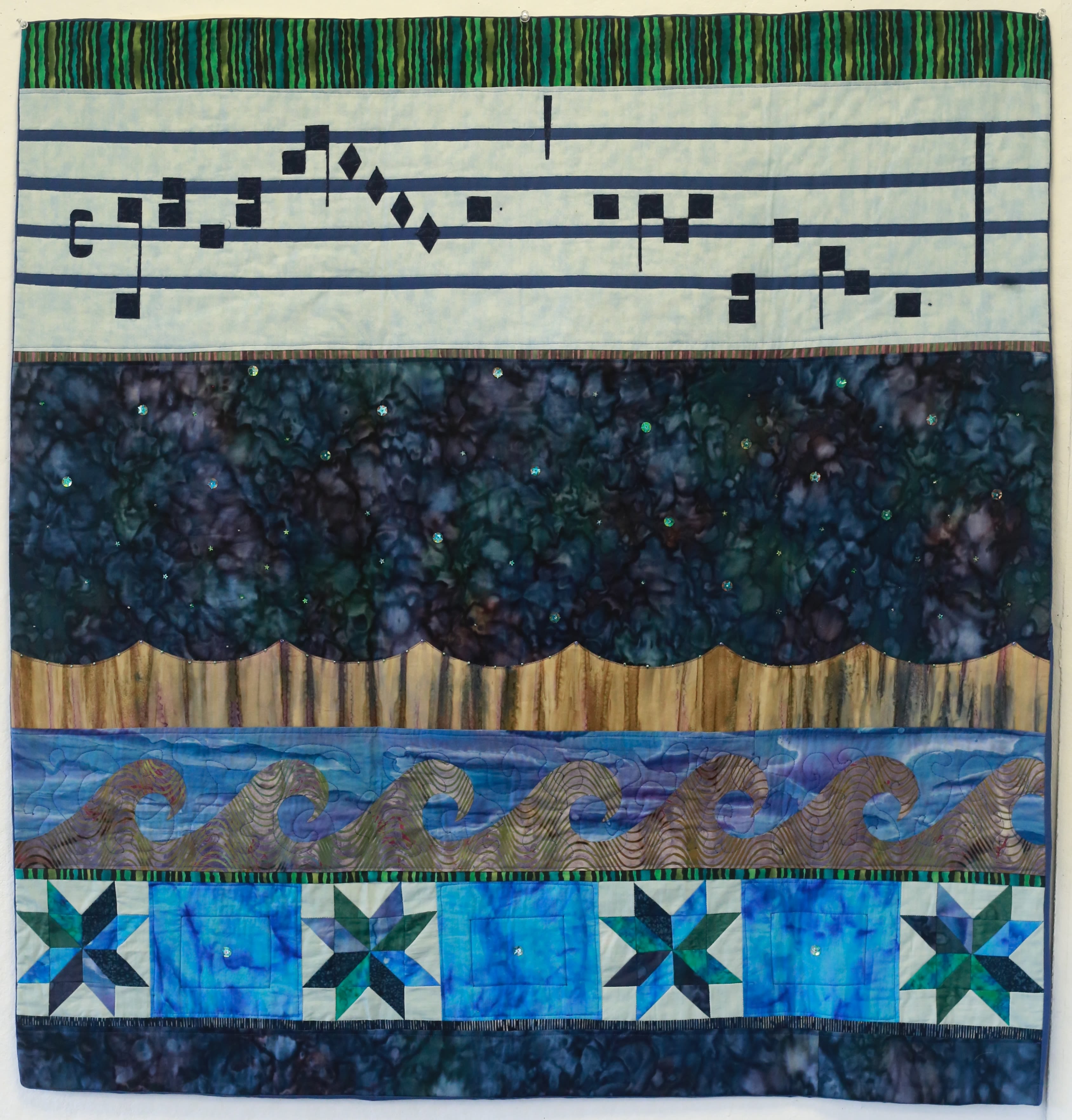
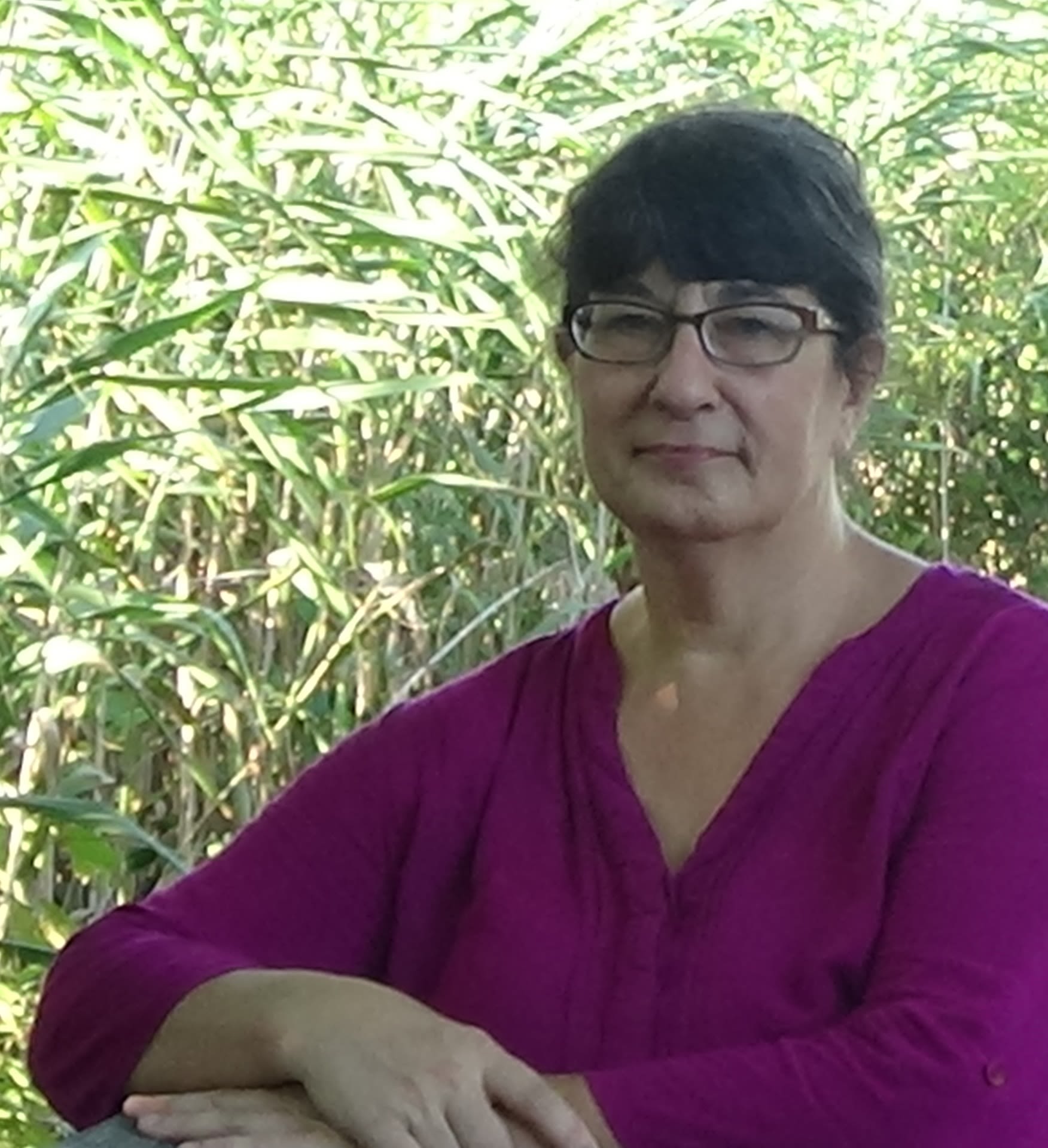
"As an artist, I enjoy treading the line between imposing and relinquishing control. The fact that it isn’t always a choice I chalk up to the human condition."

"As an artist, I enjoy treading the line between imposing and relinquishing control. The fact that it isn’t always a choice I chalk up to the human condition."

About my quilts
My quilts are first of all an expression of my love of textiles in general (from my grandmother’s 1930s aprons and kitchen curtains to Japanese kimono prints to ancient Egyptian mummy wrappings). My early interests were in pen and ink drawing and collage, while I developed my textile skills through crafting. A quilter since my teens, I began to explore the expressive possibilities of cloth in my twenties. I enjoy making work that is about the materials themselves – cloth, color, shape. Much of the fabric I use I dye myself.
Dyeing fabric requires precise measurement of chemicals, pigments or botanicals, water, and cloth to get remarkably unpredictable results – a haphazard form of chemical engineering, I suppose. The fabric itself may lie flat on the cutting table, but it lives in three dimensions. Only people who find the chaos factor part of the fun work in textiles. I enjoy the relationship of this unpredictability to the often random nature of the materials available to earlier American quilters making objects both utilitarian and aesthetic from the scraps at hand.
You will notice that I have a bit of an obsession with the Log Cabin pattern, one that can be seen in those ancient mummy wrappings as well as in innumerable 19th-century American quilts, decorative Korean pojagi cloths, and elsewhere. It is a satisfying design, growing out from the center in ways that can be made orderly or not.
Some of my other grid-based designs seem to me to be a form of map; like cities and neighborhoods, some are planned and some simply grow on their own. As an artist, I enjoy treading the line between imposing and relinquishing control. The fact that it isn’t always a choice I chalk up to the human condition.
Methods + Materials
Most of the piecing and some of the quilting is done on the sewing machine with cotton or cotton-covered polyester thread. Most of the visible quilting is done by hand (which I prefer) with either cotton or rayon thread. Batting is either all-polyester (most larger pieces) or all-cotton (most smaller pieces). The hand-dyed fabrics are cotton plain-weave or rayon twill dyed with PRO MX fiber-reactive dyes (or, in one case, black walnut hulls).
About my quilts
My quilts are first of all an expression of my love of textiles in general (from my grandmother’s 1930s aprons and kitchen curtains to Japanese kimono prints to ancient Egyptian mummy wrappings). My early interests were in pen and ink drawing and collage, while I developed my textile skills through crafting. A quilter since my teens, I began to explore the expressive possibilities of cloth in my twenties. I enjoy making work that is about the materials themselves – cloth, color, shape. Much of the fabric I use I dye myself.
Dyeing fabric requires precise measurement of chemicals, pigments or botanicals, water, and cloth to get remarkably unpredictable results – a haphazard form of chemical engineering, I suppose. The fabric itself may lie flat on the cutting table, but it lives in three dimensions. Only people who find the chaos factor part of the fun work in textiles. I enjoy the relationship of this unpredictability to the often random nature of the materials available to earlier American quilters making objects both utilitarian and aesthetic from the scraps at hand.
You will notice that I have a bit of an obsession with the Log Cabin pattern, one that can be seen in those ancient mummy wrappings as well as in innumerable 19th-century American quilts, decorative Korean pojagi cloths, and elsewhere. It is a satisfying design, growing out from the center in ways that can be made orderly or not.
Some of my other grid-based designs seem to me to be a form of map; like cities and neighborhoods, some are planned and some simply grow on their own. As an artist, I enjoy treading the line between imposing and relinquishing control. The fact that it isn’t always a choice I chalk up to the human condition.
Methods + Materials
Most of the piecing and some of the quilting is done on the sewing machine with cotton or cotton-covered polyester thread. Most of the visible quilting is done by hand (which I prefer) with either cotton or rayon thread. Batting is either all-polyester (most larger pieces) or all-cotton (most smaller pieces). The hand-dyed fabrics are cotton plain-weave or rayon twill dyed with PRO MX fiber-reactive dyes (or, in one case, black walnut hulls).

SLIDE SHOW
Click on any image to begin.
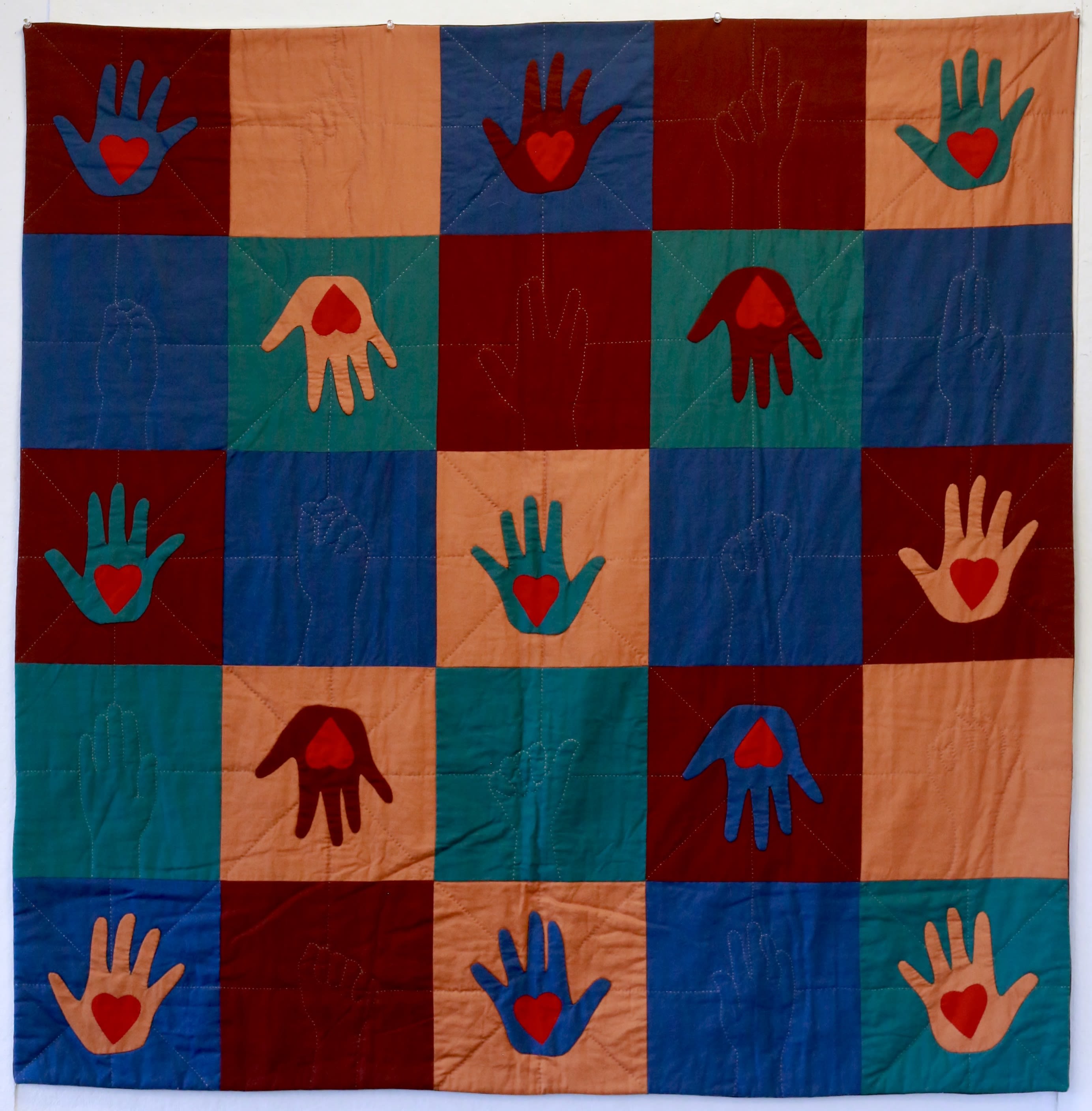

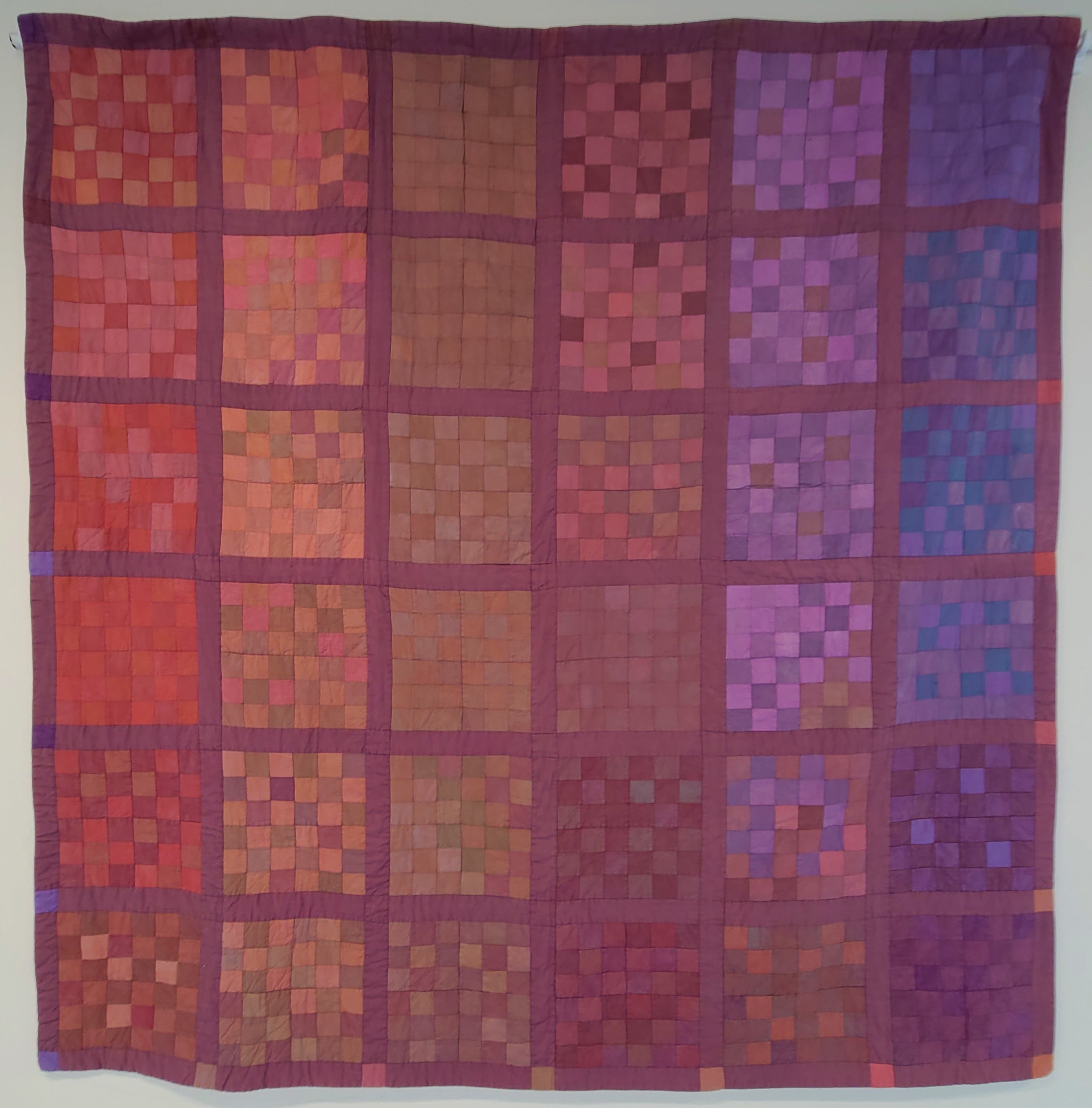
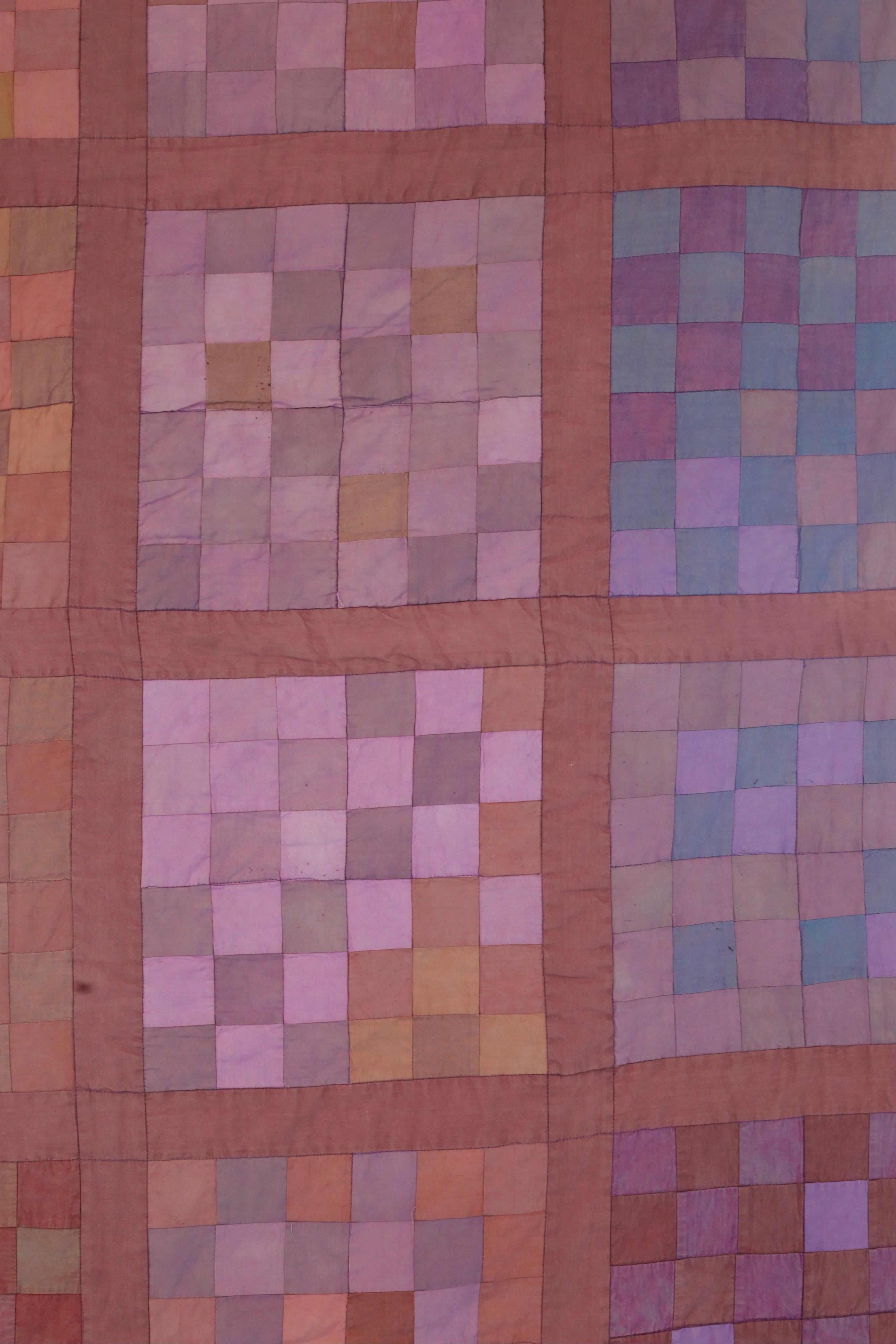
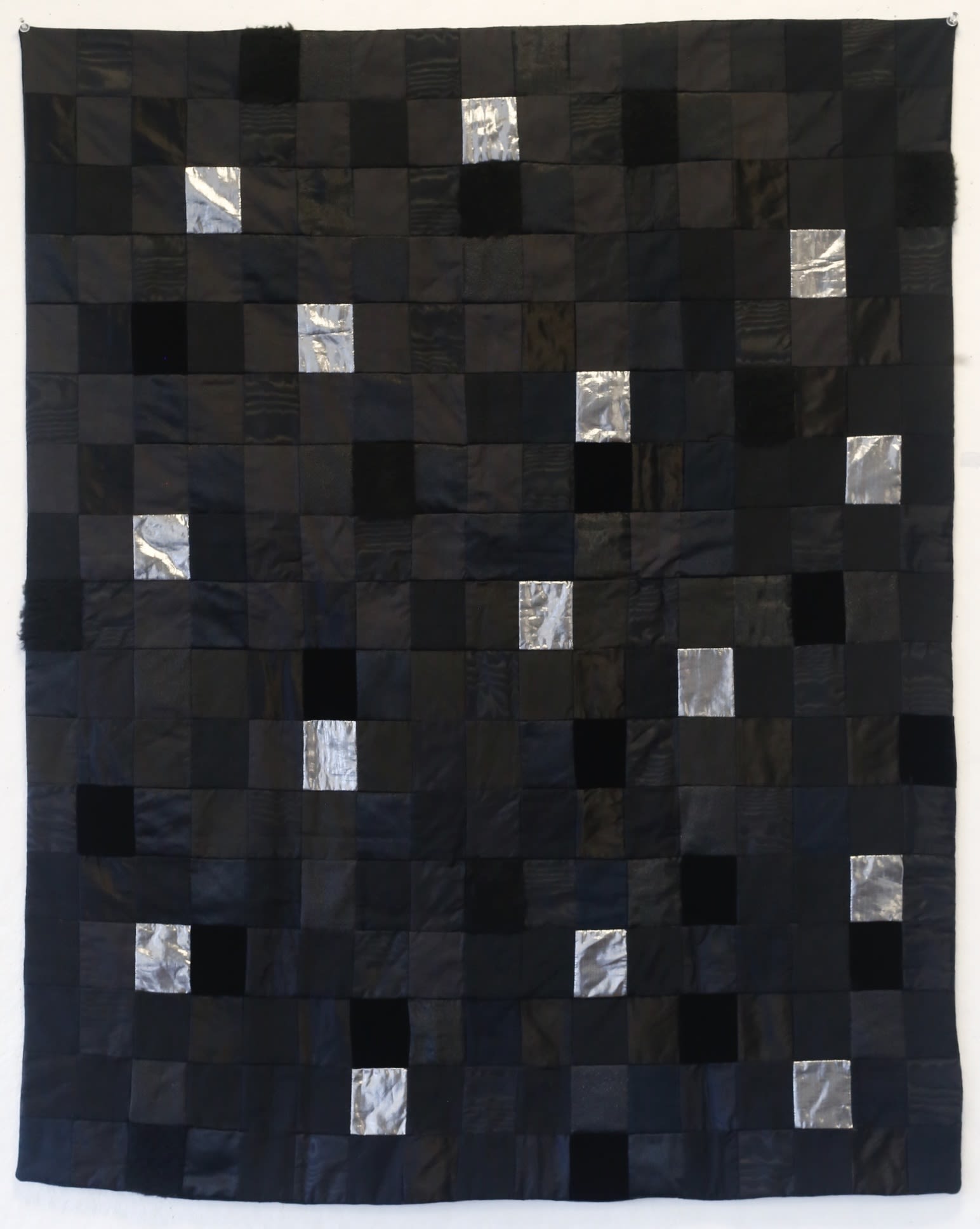
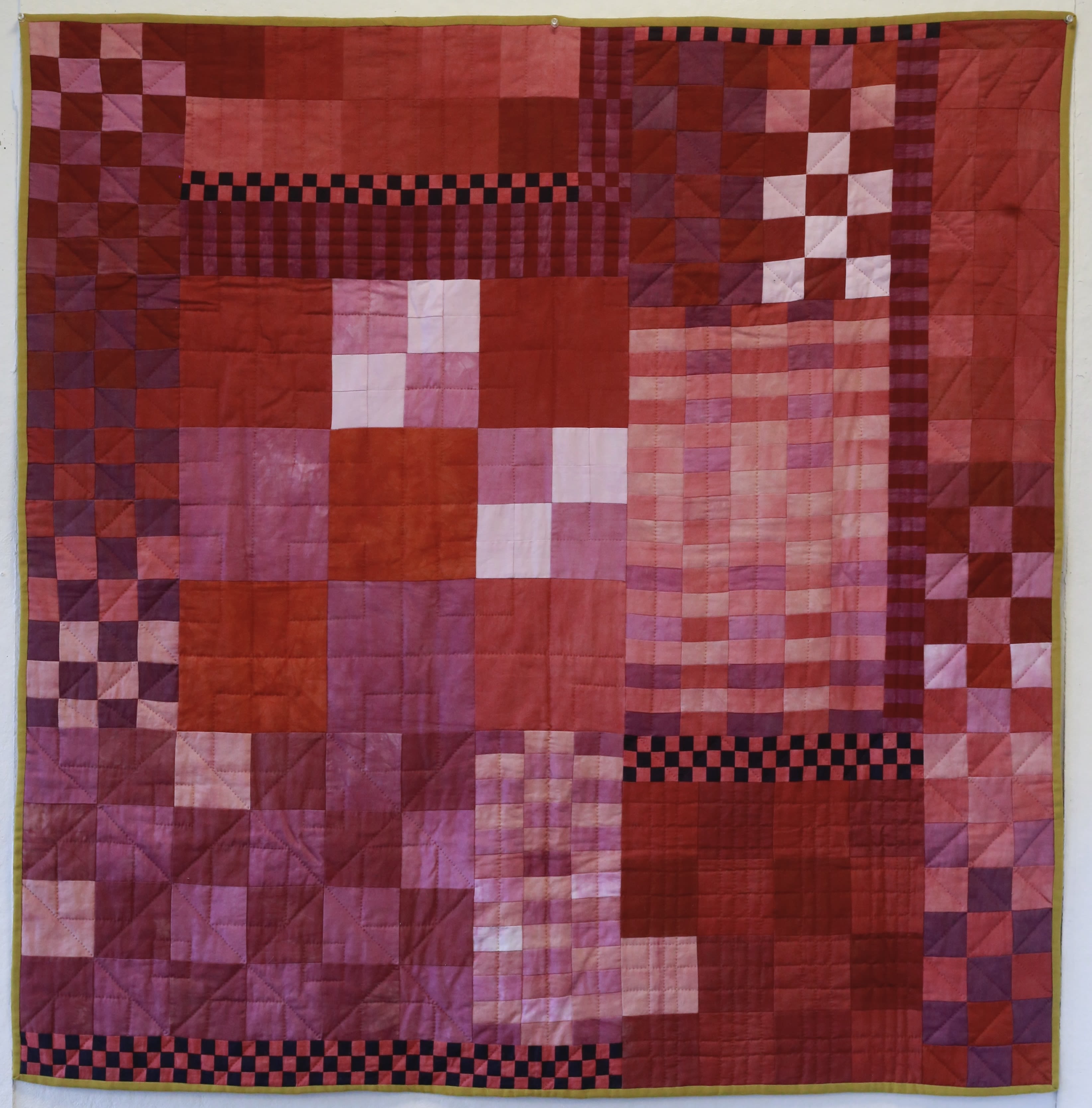
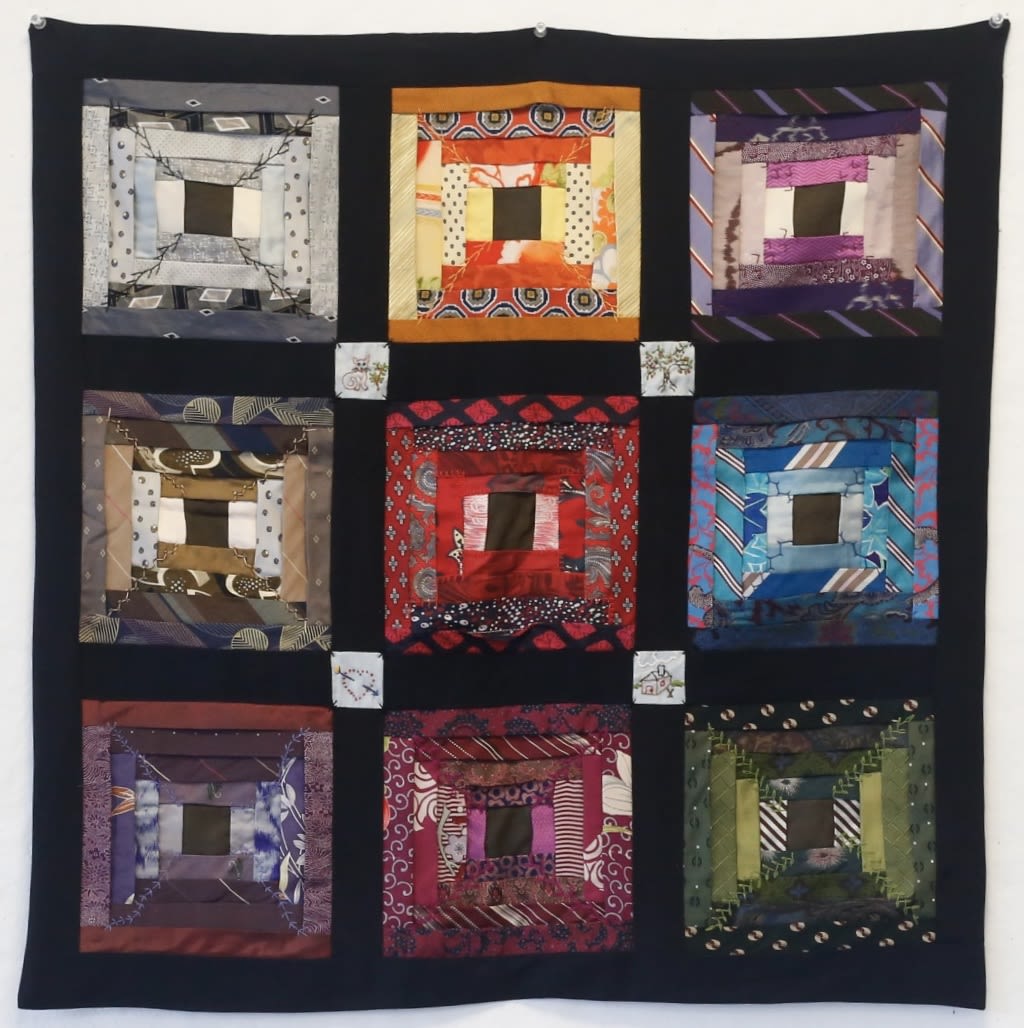
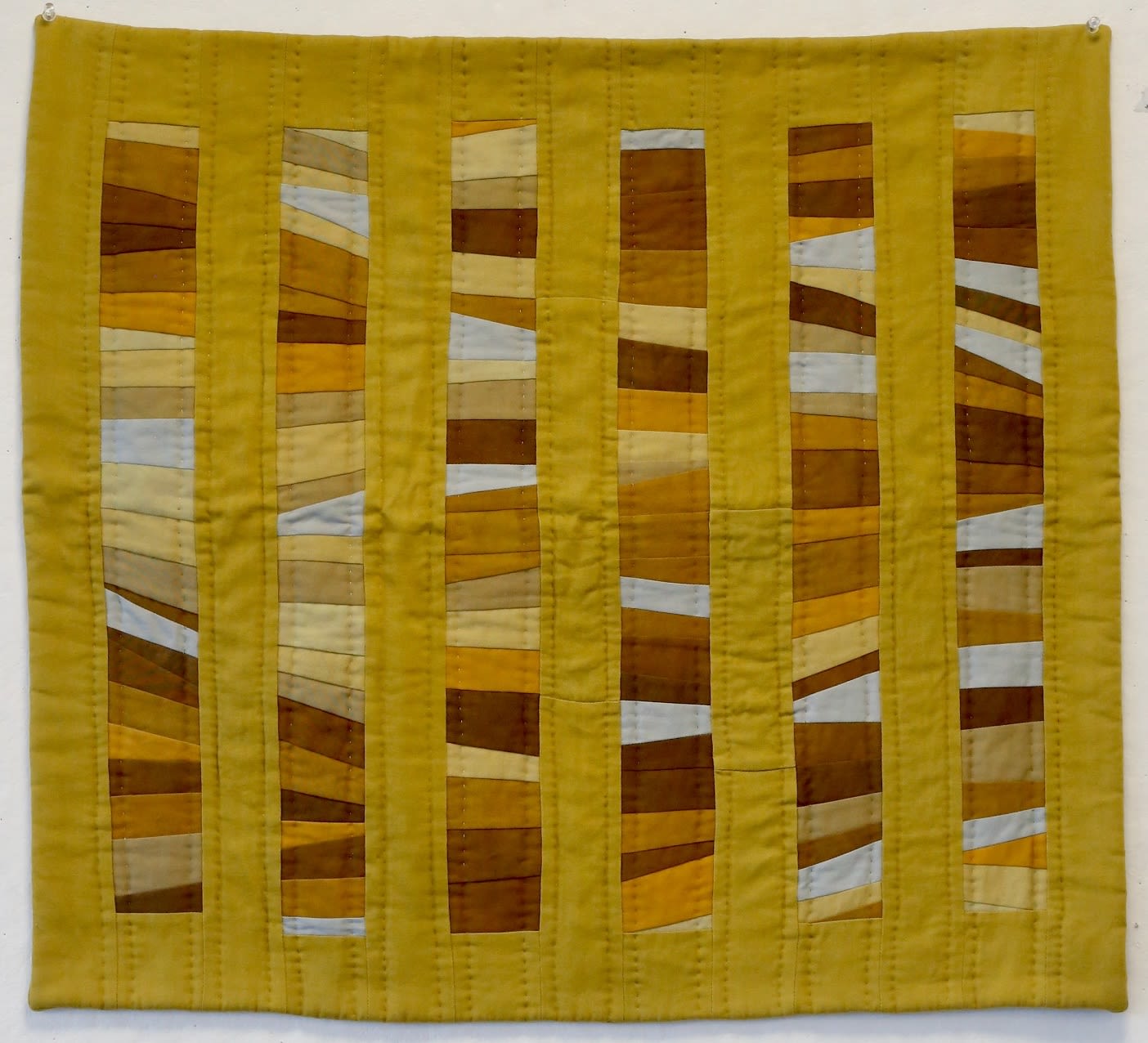
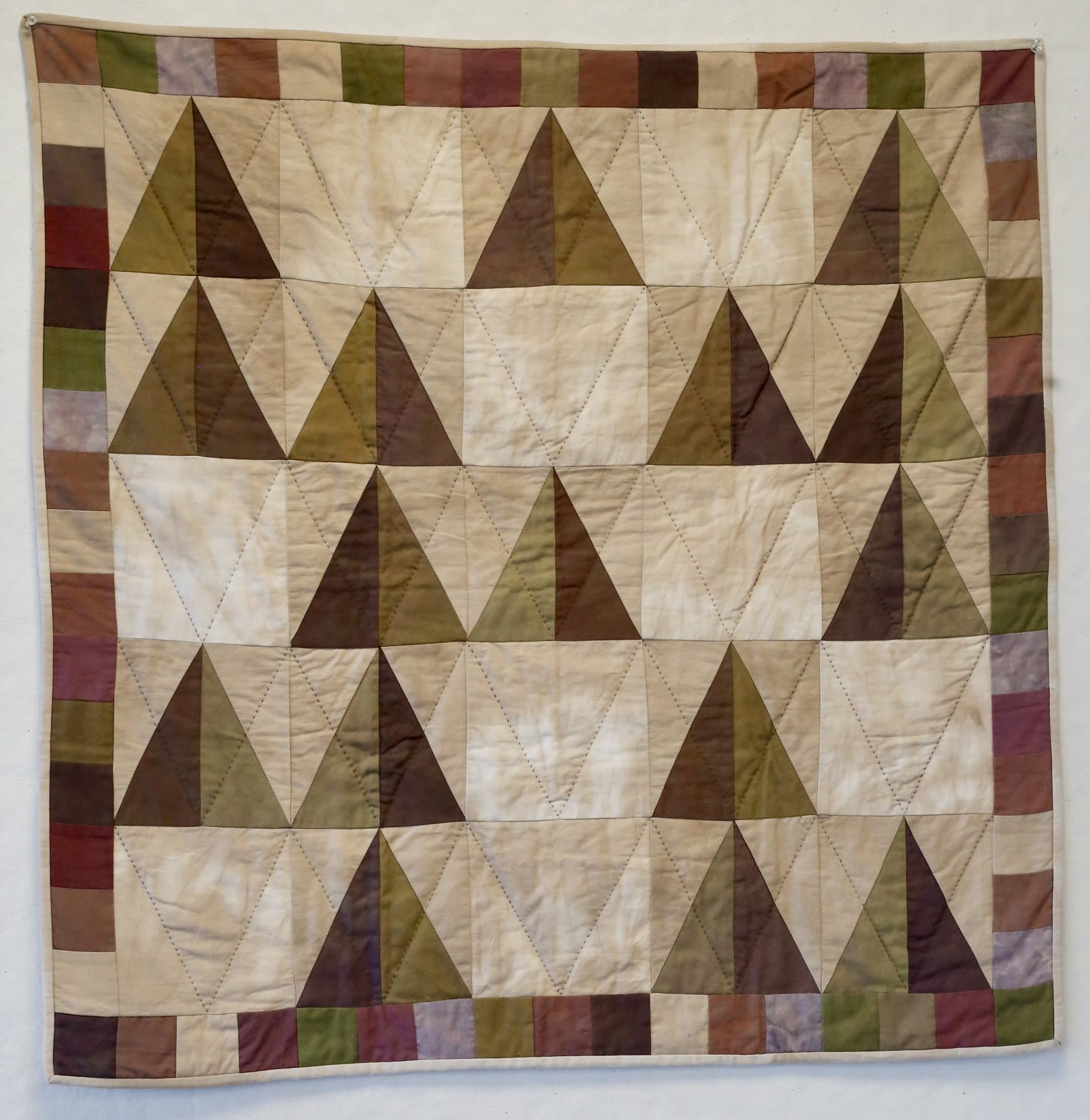
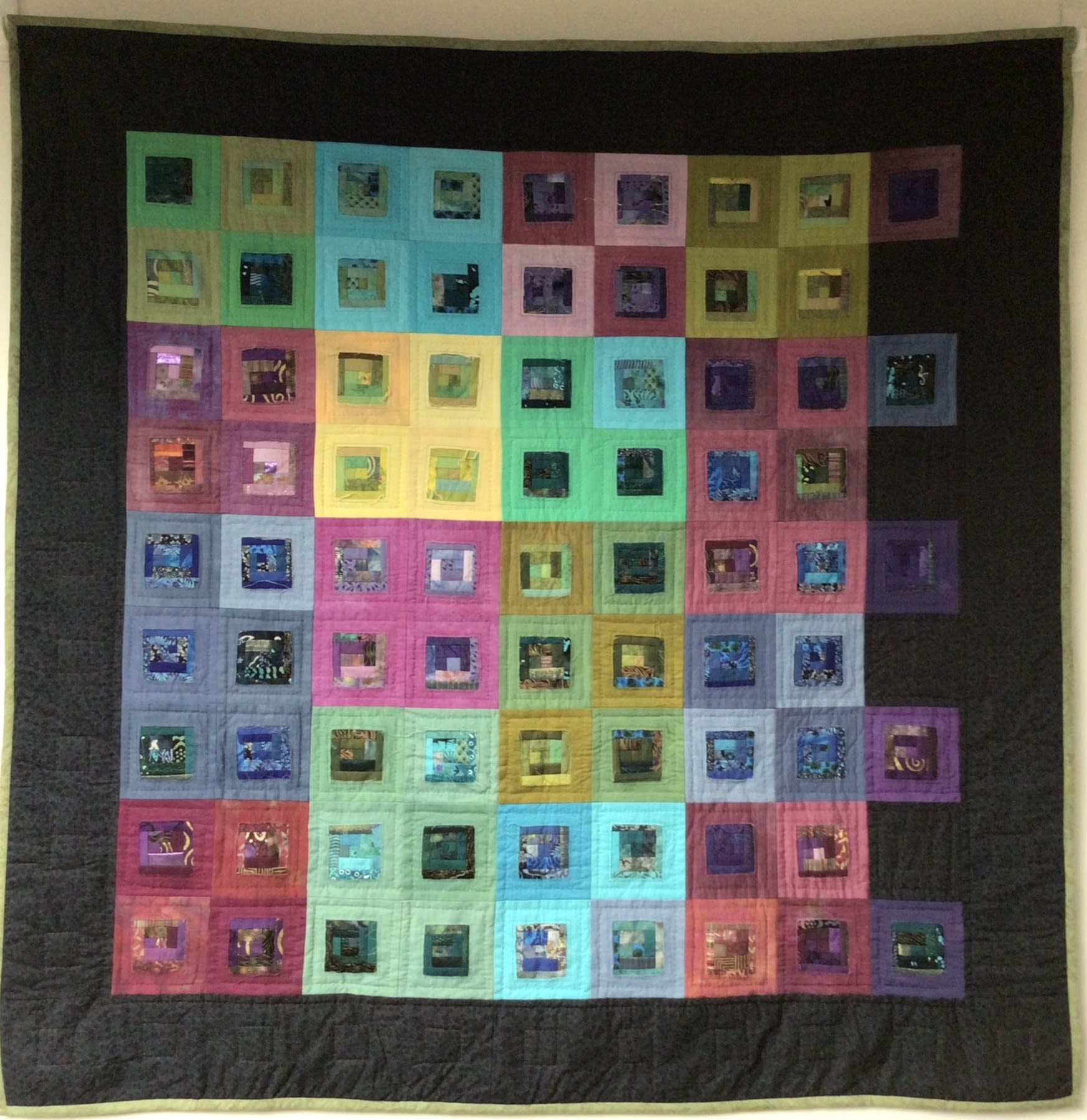
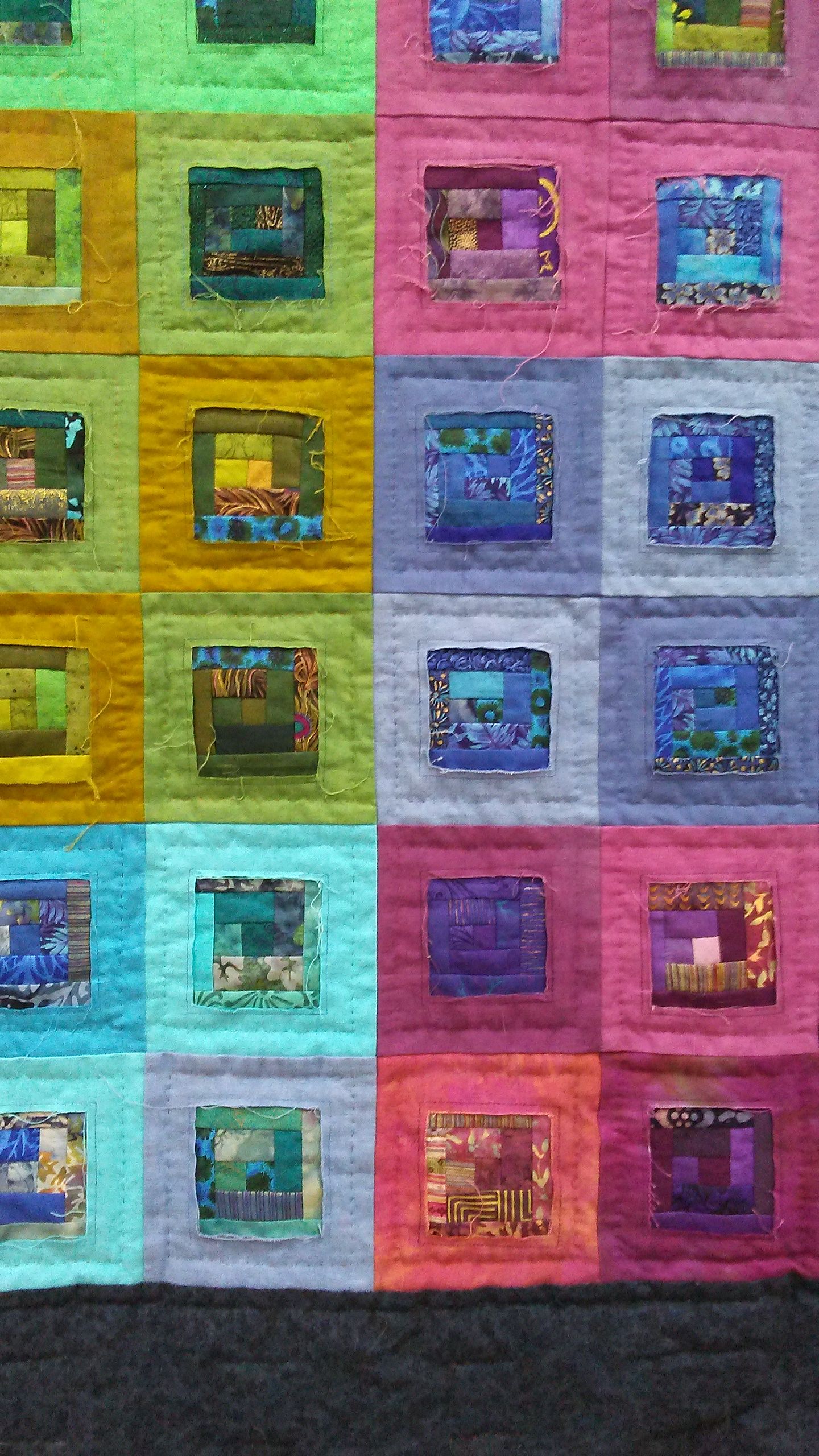
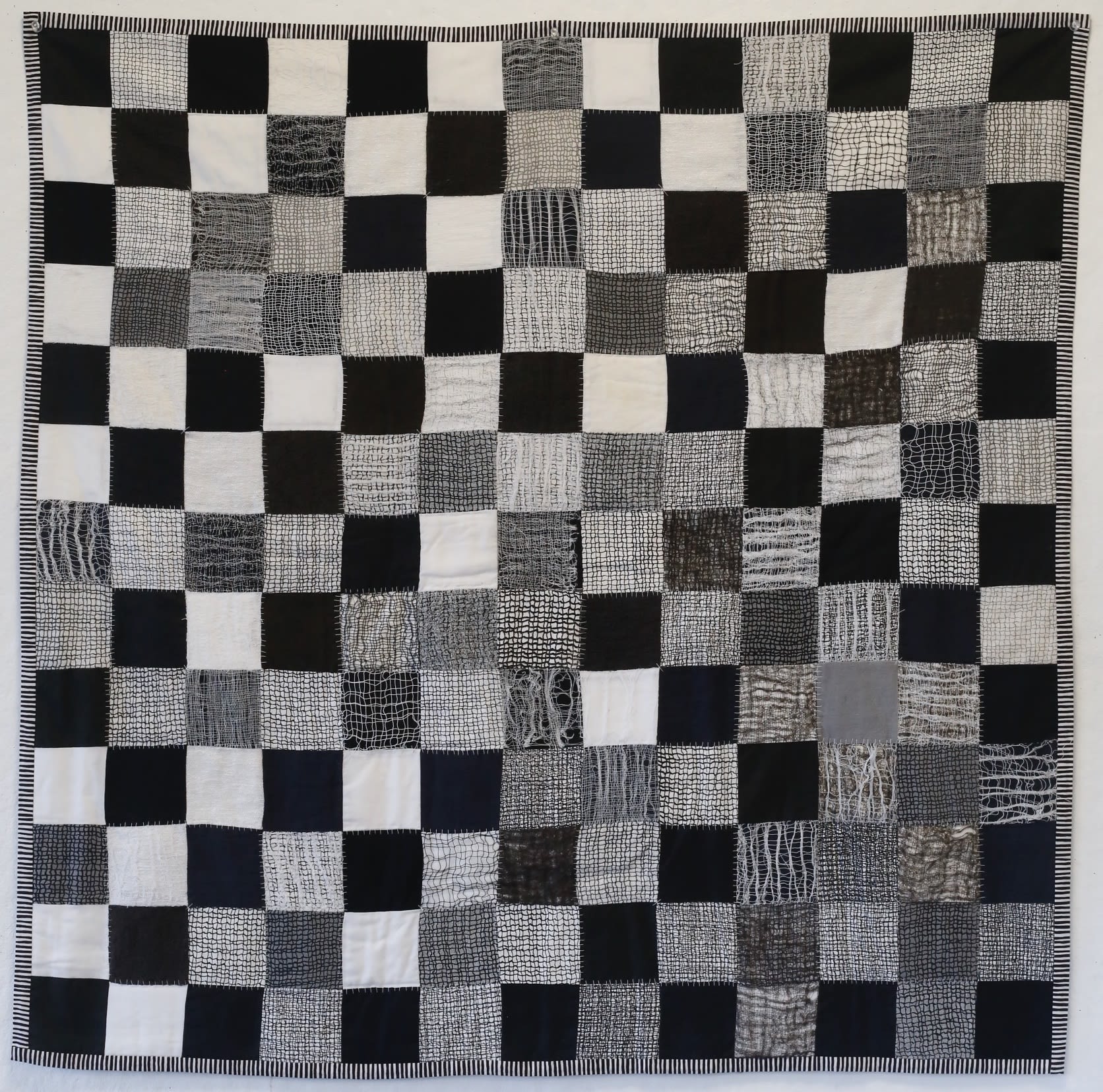
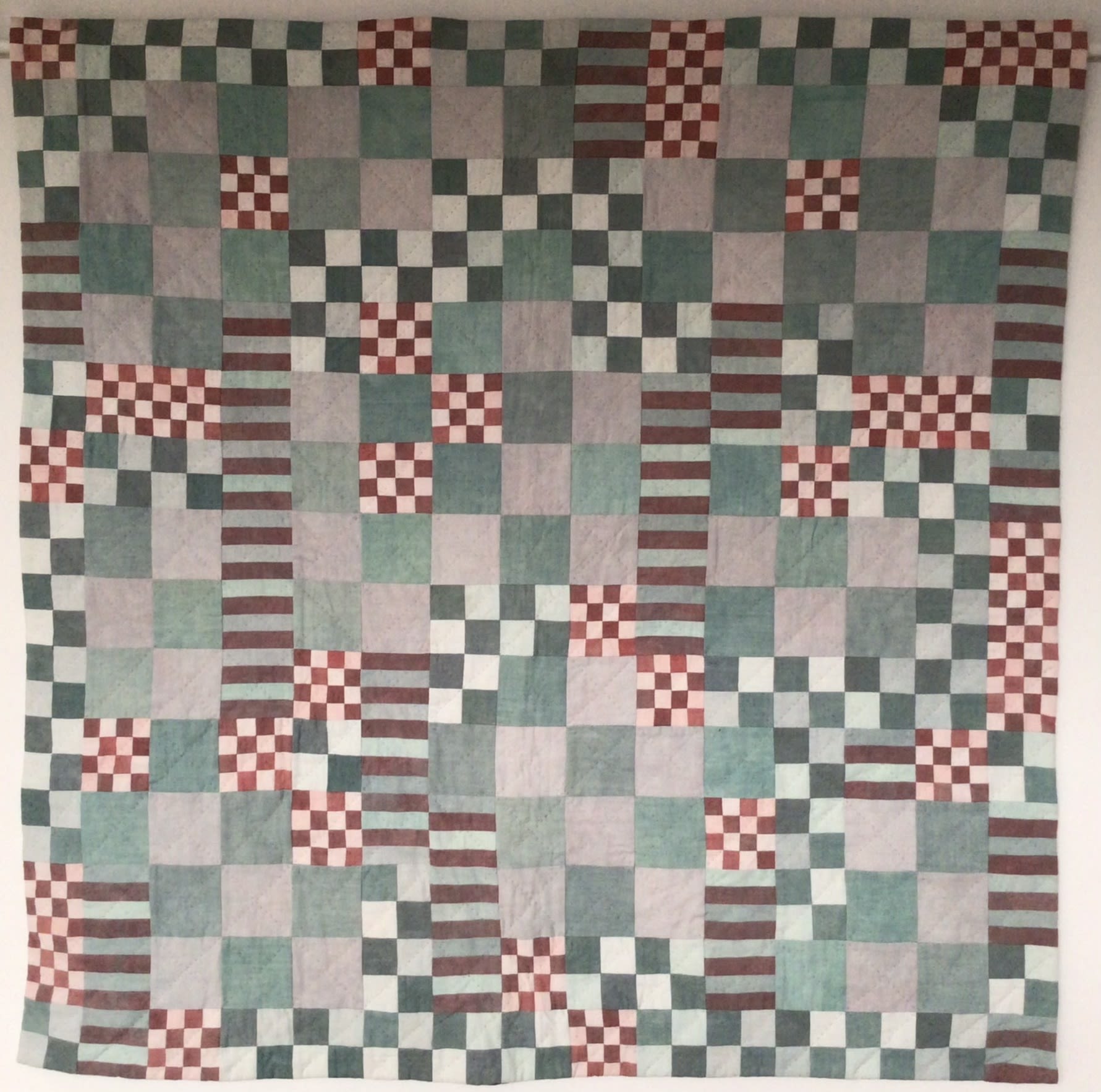

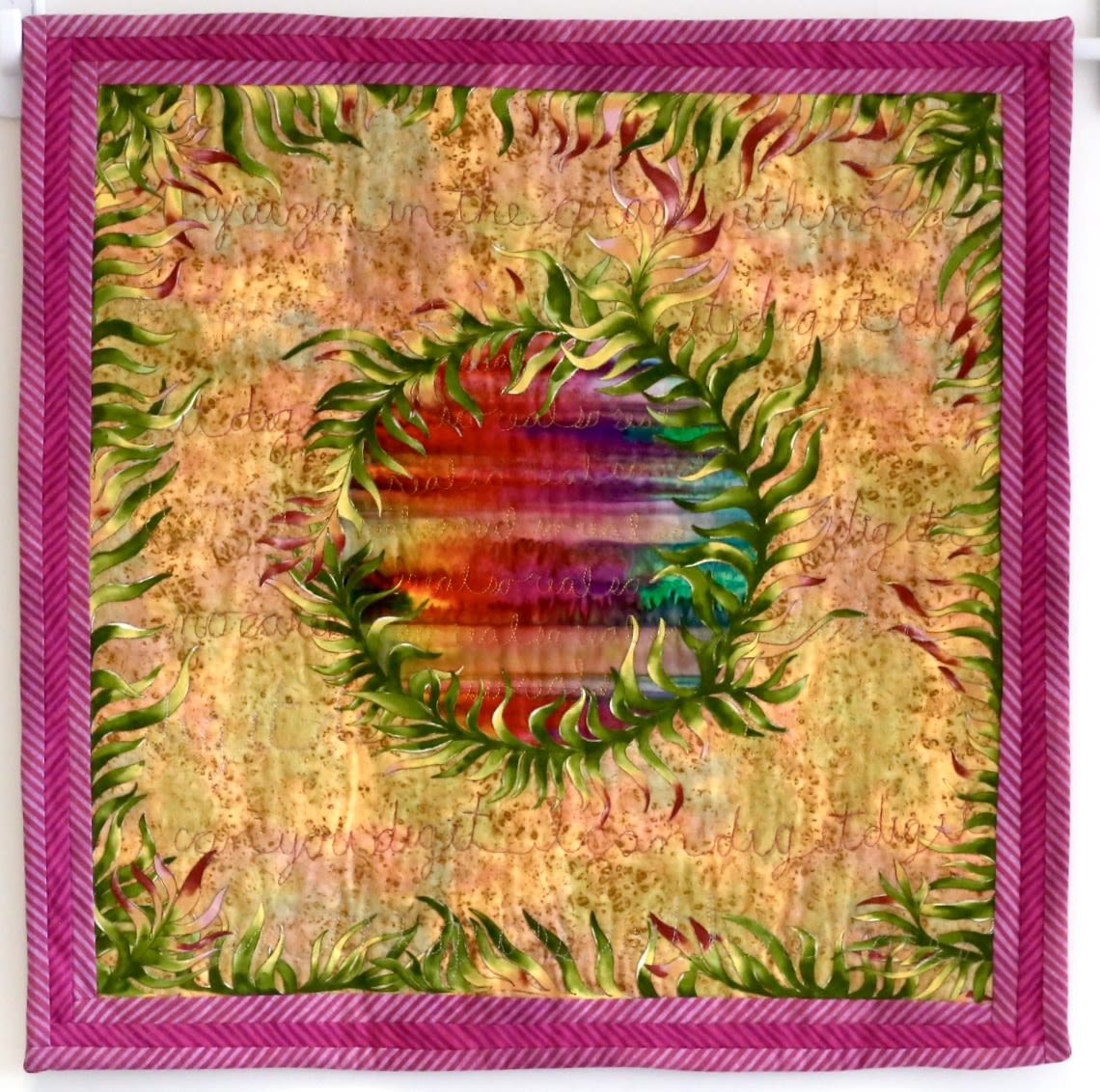

Heart in Hand (2004) ~ 48.5 x 48.5 Commercially-dyed cotton. Heart in hand is a traditional applique pattern (i.e., shapes cut out and applied to a background). I did this one in a combination of applique (shape on top of background – the hands) and reverse applique (shape cut out of top material so background shows through – the hearts). I saw the open hand in the pattern as a specific gesture that suggested including others. The quilted hand gestures are ones I commonly make myself and are based on photocopies of my own hand.
Heart in Hand (2004) ~ 48.5 x 48.5 Commercially-dyed cotton. Heart in hand is a traditional applique pattern (i.e., shapes cut out and applied to a background). I did this one in a combination of applique (shape on top of background – the hands) and reverse applique (shape cut out of top material so background shows through – the hearts). I saw the open hand in the pattern as a specific gesture that suggested including others. The quilted hand gestures are ones I commonly make myself and are based on photocopies of my own hand.

Ave maris stella (2010) ~ 41 x 43.5 Commercially-printed and dyed cotton, sequins, glass beads. This is the result of another guild challenge; I made it to hang in my RWU office. “Ave maris stella” is an early medieval hymn characterizing the Virgin Mary as the “star of the sea.”
Ave maris stella (2010) ~ 41 x 43.5 Commercially-printed and dyed cotton, sequins, glass beads. This is the result of another guild challenge; I made it to hang in my RWU office. “Ave maris stella” is an early medieval hymn characterizing the Virgin Mary as the “star of the sea.”

36 Patch (2000) ~ 65 x 64.5 Hand-dyed cotton. Where does purple turn into brown and brown into purple?
36 Patch (2000) ~ 65 x 64.5 Hand-dyed cotton. Where does purple turn into brown and brown into purple?

36 Patch, detail
36 Patch, detail

Black(s) (2001) ~ 33 x 41 Assorted commercial fabrics. This is an exploration of hues and – especially – textures. It’s unfortunate you can’t touch the photo…
Black(s) (2001) ~ 33 x 41 Assorted commercial fabrics. This is an exploration of hues and – especially – textures. It’s unfortunate you can’t touch the photo…

Map #1 (1999) ~ 47.5 x 49 Hand-dyed rayon and cotton. This is the first quilt I made entirely improvisationally: I created many small units and then moved them around until I thought the design worked.
Map #1 (1999) ~ 47.5 x 49 Hand-dyed rayon and cotton. This is the first quilt I made entirely improvisationally: I created many small units and then moved them around until I thought the design worked.

Silk Log Cabins (2005) ~ 28 x 28 Silk ties, silk, rayon, cotton embroidery. I wanted to recreate the feeling of late-19th-century embroidered silk crazy quilts, but I am too lazy to go the whole nine yards, so to speak.
Silk Log Cabins (2005) ~ 28 x 28 Silk ties, silk, rayon, cotton embroidery. I wanted to recreate the feeling of late-19th-century embroidered silk crazy quilts, but I am too lazy to go the whole nine yards, so to speak.

Chartreuse and Puce (1999) ~ 28 x 25 Hand-dyed rayon and cotton. This was a lesson in how monochromaticism can go wrong, as I ended up ripping up most of the quilt top to insert the gray stripes.
Chartreuse and Puce (1999) ~ 28 x 25 Hand-dyed rayon and cotton. This was a lesson in how monochromaticism can go wrong, as I ended up ripping up most of the quilt top to insert the gray stripes.

Pyramids (1999) ~ 32.5 x 32.5 Hand-dyed cotton and rayon (fiber-reactive dyes and black walnuts). I spent a semester in my graduate textiles program experimenting with natural dyes (i.e., dying with plants). I discovered that black walnut hulls work really well on wool, producing a gorgeous range of rich browns, but not so much on cotton or rayon. They do work spectacularly well on human skin, however…
Pyramids (1999) ~ 32.5 x 32.5 Hand-dyed cotton and rayon (fiber-reactive dyes and black walnuts). I spent a semester in my graduate textiles program experimenting with natural dyes (i.e., dying with plants). I discovered that black walnut hulls work really well on wool, producing a gorgeous range of rich browns, but not so much on cotton or rayon. They do work spectacularly well on human skin, however…

Nanocabins (2019) ~ 54.5 x 54 Commercially-printed cotton, hand-dyed cotton. The tiny (and addictive) log cabin blocks were made from scraps with no definite thought as to their ultimate use. I showed the pile of 70+ of them to late long-time friend and Bristol artist Ilse Schaler, who gave me the inspiration for the arrangement.
Nanocabins (2019) ~ 54.5 x 54 Commercially-printed cotton, hand-dyed cotton. The tiny (and addictive) log cabin blocks were made from scraps with no definite thought as to their ultimate use. I showed the pile of 70+ of them to late long-time friend and Bristol artist Ilse Schaler, who gave me the inspiration for the arrangement.

Nanocabins, detail
Nanocabins, detail

Ersatz #1 (1999) ~ 41 x 40.5 Screen-printed cotton and rayon, cheesecloth, machine-stitched netting. Some of these blocks are made from loosely-woven fabric, some are “fabric” made on the sewing machine, and some are simply screen-printed with a drawn image of fabric. Have fun.
Ersatz #1 (1999) ~ 41 x 40.5 Screen-printed cotton and rayon, cheesecloth, machine-stitched netting. Some of these blocks are made from loosely-woven fabric, some are “fabric” made on the sewing machine, and some are simply screen-printed with a drawn image of fabric. Have fun.

Map #2 (2017) ~ 37.5 x 37 Hand-dyed cotton. This is one of several pieces using the same lot of pastel-dyed fabric in blues and pinks. I’ve made a number of quilts in this style – an improvisational collage of strips, squares, and checks – and they look like maps or aerial photos to me.
Map #2 (2017) ~ 37.5 x 37 Hand-dyed cotton. This is one of several pieces using the same lot of pastel-dyed fabric in blues and pinks. I’ve made a number of quilts in this style – an improvisational collage of strips, squares, and checks – and they look like maps or aerial photos to me.

Ersatz #2 (2023) ~ 25.5 x 25.5 Commercially-printed cotton and hand-dyed cotton. I found the printed fabric at an improbable warehouse store somewhere in the wilds of rural Indiana. I didn’t particularly like it, but for some reason it fascinated me. Every other block of this quilt is a piece of the printed fabric; the alternate blocks are pieced by me in imitation of the fabric using hand-dyed colors.
Ersatz #2 (2023) ~ 25.5 x 25.5 Commercially-printed cotton and hand-dyed cotton. I found the printed fabric at an improbable warehouse store somewhere in the wilds of rural Indiana. I didn’t particularly like it, but for some reason it fascinated me. Every other block of this quilt is a piece of the printed fabric; the alternate blocks are pieced by me in imitation of the fabric using hand-dyed colors.

Grazin’ in the Grass (2005) ~ 20 x 20 Commercially-printed cotton. This was the result of a Bloomington (IN) Quilters Guild challenge to base a quilt on song lyrics. Thank you, Friends of Distinction; I just about wore out the 45 in junior high school.
Grazin’ in the Grass (2005) ~ 20 x 20 Commercially-printed cotton. This was the result of a Bloomington (IN) Quilters Guild challenge to base a quilt on song lyrics. Thank you, Friends of Distinction; I just about wore out the 45 in junior high school.
















Heart in Hand (2004) ~ 48.5 x 48.5 Commercially-dyed cotton. Heart in hand is a traditional applique pattern (i.e., shapes cut out and applied to a background). I did this one in a combination of applique (shape on top of background – the hands) and reverse applique (shape cut out of top material so background shows through – the hearts). I saw the open hand in the pattern as a specific gesture that suggested including others. The quilted hand gestures are ones I commonly make myself and are based on photocopies of my own hand.
Heart in Hand (2004) ~ 48.5 x 48.5 Commercially-dyed cotton. Heart in hand is a traditional applique pattern (i.e., shapes cut out and applied to a background). I did this one in a combination of applique (shape on top of background – the hands) and reverse applique (shape cut out of top material so background shows through – the hearts). I saw the open hand in the pattern as a specific gesture that suggested including others. The quilted hand gestures are ones I commonly make myself and are based on photocopies of my own hand.

Ave maris stella (2010) ~ 41 x 43.5 Commercially-printed and dyed cotton, sequins, glass beads. This is the result of another guild challenge; I made it to hang in my RWU office. “Ave maris stella” is an early medieval hymn characterizing the Virgin Mary as the “star of the sea.”
Ave maris stella (2010) ~ 41 x 43.5 Commercially-printed and dyed cotton, sequins, glass beads. This is the result of another guild challenge; I made it to hang in my RWU office. “Ave maris stella” is an early medieval hymn characterizing the Virgin Mary as the “star of the sea.”

36 Patch (2000) ~ 65 x 64.5 Hand-dyed cotton. Where does purple turn into brown and brown into purple?
36 Patch (2000) ~ 65 x 64.5 Hand-dyed cotton. Where does purple turn into brown and brown into purple?

36 Patch, detail
36 Patch, detail

Black(s) (2001) ~ 33 x 41 Assorted commercial fabrics. This is an exploration of hues and – especially – textures. It’s unfortunate you can’t touch the photo…
Black(s) (2001) ~ 33 x 41 Assorted commercial fabrics. This is an exploration of hues and – especially – textures. It’s unfortunate you can’t touch the photo…

Map #1 (1999) ~ 47.5 x 49 Hand-dyed rayon and cotton. This is the first quilt I made entirely improvisationally: I created many small units and then moved them around until I thought the design worked.
Map #1 (1999) ~ 47.5 x 49 Hand-dyed rayon and cotton. This is the first quilt I made entirely improvisationally: I created many small units and then moved them around until I thought the design worked.

Silk Log Cabins (2005) ~ 28 x 28 Silk ties, silk, rayon, cotton embroidery. I wanted to recreate the feeling of late-19th-century embroidered silk crazy quilts, but I am too lazy to go the whole nine yards, so to speak.
Silk Log Cabins (2005) ~ 28 x 28 Silk ties, silk, rayon, cotton embroidery. I wanted to recreate the feeling of late-19th-century embroidered silk crazy quilts, but I am too lazy to go the whole nine yards, so to speak.

Chartreuse and Puce (1999) ~ 28 x 25 Hand-dyed rayon and cotton. This was a lesson in how monochromaticism can go wrong, as I ended up ripping up most of the quilt top to insert the gray stripes.
Chartreuse and Puce (1999) ~ 28 x 25 Hand-dyed rayon and cotton. This was a lesson in how monochromaticism can go wrong, as I ended up ripping up most of the quilt top to insert the gray stripes.

Pyramids (1999) ~ 32.5 x 32.5 Hand-dyed cotton and rayon (fiber-reactive dyes and black walnuts). I spent a semester in my graduate textiles program experimenting with natural dyes (i.e., dying with plants). I discovered that black walnut hulls work really well on wool, producing a gorgeous range of rich browns, but not so much on cotton or rayon. They do work spectacularly well on human skin, however…
Pyramids (1999) ~ 32.5 x 32.5 Hand-dyed cotton and rayon (fiber-reactive dyes and black walnuts). I spent a semester in my graduate textiles program experimenting with natural dyes (i.e., dying with plants). I discovered that black walnut hulls work really well on wool, producing a gorgeous range of rich browns, but not so much on cotton or rayon. They do work spectacularly well on human skin, however…

Nanocabins (2019) ~ 54.5 x 54 Commercially-printed cotton, hand-dyed cotton. The tiny (and addictive) log cabin blocks were made from scraps with no definite thought as to their ultimate use. I showed the pile of 70+ of them to late long-time friend and Bristol artist Ilse Schaler, who gave me the inspiration for the arrangement.
Nanocabins (2019) ~ 54.5 x 54 Commercially-printed cotton, hand-dyed cotton. The tiny (and addictive) log cabin blocks were made from scraps with no definite thought as to their ultimate use. I showed the pile of 70+ of them to late long-time friend and Bristol artist Ilse Schaler, who gave me the inspiration for the arrangement.

Nanocabins, detail
Nanocabins, detail

Ersatz #1 (1999) ~ 41 x 40.5 Screen-printed cotton and rayon, cheesecloth, machine-stitched netting. Some of these blocks are made from loosely-woven fabric, some are “fabric” made on the sewing machine, and some are simply screen-printed with a drawn image of fabric. Have fun.
Ersatz #1 (1999) ~ 41 x 40.5 Screen-printed cotton and rayon, cheesecloth, machine-stitched netting. Some of these blocks are made from loosely-woven fabric, some are “fabric” made on the sewing machine, and some are simply screen-printed with a drawn image of fabric. Have fun.

Map #2 (2017) ~ 37.5 x 37 Hand-dyed cotton. This is one of several pieces using the same lot of pastel-dyed fabric in blues and pinks. I’ve made a number of quilts in this style – an improvisational collage of strips, squares, and checks – and they look like maps or aerial photos to me.
Map #2 (2017) ~ 37.5 x 37 Hand-dyed cotton. This is one of several pieces using the same lot of pastel-dyed fabric in blues and pinks. I’ve made a number of quilts in this style – an improvisational collage of strips, squares, and checks – and they look like maps or aerial photos to me.

Ersatz #2 (2023) ~ 25.5 x 25.5 Commercially-printed cotton and hand-dyed cotton. I found the printed fabric at an improbable warehouse store somewhere in the wilds of rural Indiana. I didn’t particularly like it, but for some reason it fascinated me. Every other block of this quilt is a piece of the printed fabric; the alternate blocks are pieced by me in imitation of the fabric using hand-dyed colors.
Ersatz #2 (2023) ~ 25.5 x 25.5 Commercially-printed cotton and hand-dyed cotton. I found the printed fabric at an improbable warehouse store somewhere in the wilds of rural Indiana. I didn’t particularly like it, but for some reason it fascinated me. Every other block of this quilt is a piece of the printed fabric; the alternate blocks are pieced by me in imitation of the fabric using hand-dyed colors.

Grazin’ in the Grass (2005) ~ 20 x 20 Commercially-printed cotton. This was the result of a Bloomington (IN) Quilters Guild challenge to base a quilt on song lyrics. Thank you, Friends of Distinction; I just about wore out the 45 in junior high school.
Grazin’ in the Grass (2005) ~ 20 x 20 Commercially-printed cotton. This was the result of a Bloomington (IN) Quilters Guild challenge to base a quilt on song lyrics. Thank you, Friends of Distinction; I just about wore out the 45 in junior high school.

About the Artist
Catherine recently retired from her position as Professor of Music at Roger Williams University, where she established the RWU Instrumental Ensemble and taught music history, world music, and humanities. Her interest in Medieval music led her to Indiana University to work with Thomas Binkley of the Studio der Frühen Musik. She also took advantage of the opportunity to study fine arts textiles at IU with Budd Stalnaker, a student of color theorist Josef Albers and his fiber-art pioneer wife Anni, and polished her speed and efficiency on the sewing machine at the IU Opera and Ballet Costume Shop. Catherine was a founder of the early music quartet Melusine and the award-winning folk orchestra Smiling Dog Band and serves as conductor of the American Mandolin and Guitar Orchestra. She has performed extensively in genres ranging from opera to circus to jam band; she and her compositions have appeared on numerous recordings, including two with the mandolin chamber ensemble Enigmatica. Catherine enjoyed the first solo exhibition of her textile work in spring 2023 on the RWU campus.
About the Artist
Catherine recently retired from her position as Professor of Music at Roger Williams University, where she established the RWU Instrumental Ensemble and taught music history, world music, and humanities. Her interest in Medieval music led her to Indiana University to work with Thomas Binkley of the Studio der Frühen Musik. She also took advantage of the opportunity to study fine arts textiles at IU with Budd Stalnaker, a student of color theorist Josef Albers and his fiber-art pioneer wife Anni, and polished her speed and efficiency on the sewing machine at the IU Opera and Ballet Costume Shop. Catherine was a founder of the early music quartet Melusine and the award-winning folk orchestra Smiling Dog Band and serves as conductor of the American Mandolin and Guitar Orchestra. She has performed extensively in genres ranging from opera to circus to jam band; she and her compositions have appeared on numerous recordings, including two with the mandolin chamber ensemble Enigmatica. Catherine enjoyed the first solo exhibition of her textile work in spring 2023 on the RWU campus.
